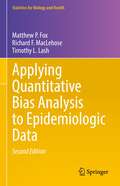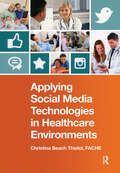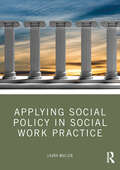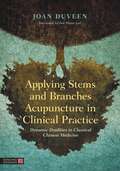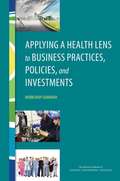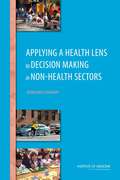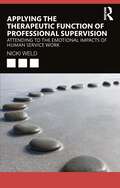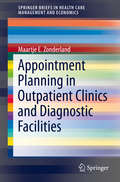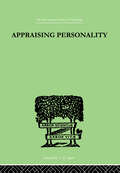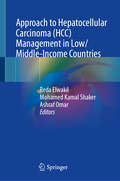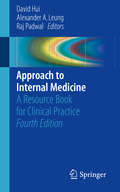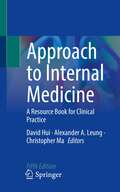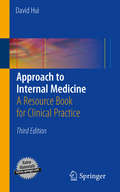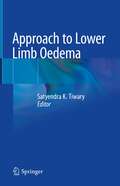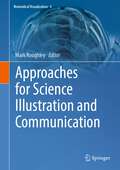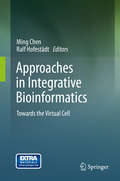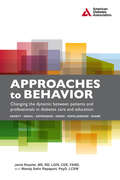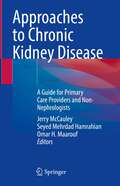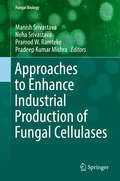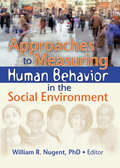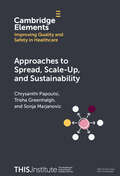- Table View
- List View
Applying Quantitative Bias Analysis to Epidemiologic Data (Statistics for Biology and Health)
by Matthew P. Fox Timothy L. Lash Aliza K. FinkThis text provides the first-ever compilation of bias analysis methods for use with epidemiologic data. It guides the reader through the planning stages of bias analysis, including the design of validation studies and the collection of validity data from other sources. Three chapters present methods for corrections to address selection bias, uncontrolled confounding, and classification errors. Subsequent chapters extend these methods to multidimensional bias analysis, probabilistic bias analysis, and multiple bias analysis. The text concludes with a chapter on presentation and interpretation of bias analysis results. Although techniques for bias analysis have been available for decades, these methods are considered difficult to implement. This text not only gathers the methods into one cohesive and organized presentation, it also explains the methods in a consistent fashion and provides customizable spreadsheets to implement the solutions. By downloading the spreadsheets (available at links provided in the text), readers can follow the examples in the text and then modify the spreadsheet to complete their own bias analyses. Readers without experience using quantitative bias analysis will be able to design, implement, and understand bias analyses that address the major threats to the validity of epidemiologic research. More experienced analysts will value the compilation of bias analysis methods and links to software tools that facilitate their projects.
Applying Quantitative Bias Analysis to Epidemiologic Data (Statistics for Biology and Health)
by Matthew P. Fox Timothy L. Lash Richard F. MacLehoseThis textbook and guide focuses on methodologies for bias analysis in epidemiology and public health, not only providing updates to the first edition but also further developing methods and adding new advanced methods. As computational power available to analysts has improved and epidemiologic problems have become more advanced, missing data, Bayes, and empirical methods have become more commonly used. This new edition features updated examples throughout and adds coverage addressing: Measurement error pertaining to continuous and polytomous variables Methods surrounding person-time (rate) data Bias analysis using missing data, empirical (likelihood), and Bayes methods A unique feature of this revision is its section on best practices for implementing, presenting, and interpreting bias analyses. Pedagogically, the text guides students and professionals through the planning stages of bias analysis, including the design of validation studies and the collection of validity data from other sources. Three chapters present methods for corrections to address selection bias, uncontrolled confounding, and measurement errors, and subsequent sections extend these methods to probabilistic bias analysis, missing data methods, likelihood-based approaches, Bayesian methods, and best practices.
Applying Social Media Technologies in Healthcare Environments (HIMSS Book Series)
by Christina Beach ThielstApplying Social Media Technologies in Healthcare Environments provides an indispensable overview of successful use of the latest innovations in the healthcare provider-patient relationship. As professionals realize that success in the business of healthcare requires incorporation of the tools of social media into all aspects of their worlds and recognize the value offered by the numerous media channels, this compendium of case studies from various voices in the field-caregivers, administrators, marketers, patients, lawyers, clinicians, and healthcare information specialists-will serve as a valuable resource for novices as well as experienced communicators. Written by experienced players in the healthcare social media space and edited with the eye of an administrator, chapters provide insight into the motivation, planning, execution, and evaluation of a range of innovative social media activities. Complete with checklists, tips, and screenshots that demonstrate proven application of various social channels in a range of situations, this will be a valuable tool to maximize opportunities in meeting the challenges of new healthcare demands.
Applying Social Policy in Social Work Practice
by Laura MullenThis is an innovative text aimed at social work students and designed to develop their knowledge and understanding of social policy and how to best apply this in practice. It demonstrates how they can use such skills to support vulnerable individuals, groups and communities to achieve positive change.The relevance of social policy to people with lived experience of social work intervention is examined, and students are given the underpinning critical skills to prepare them for social work placements in various settings, and for their professional lives as qualified social work practitioners.Understanding and applying social policy is a core principle of social work which should inform practice and be used to achieve positive outcomes for service users. Students need to understand the relevance of social policy to social work practice. This book provides an overview of the historical background and the ideologies that have shaped social policy, including an analysis of the five pillars: income, health, education, housing and social services.It is a clear and accessible resource for social work students that will given them a fuller understanding of the importance of social policy and how social issues intersect for service users. There is also a study skills chapter to support students with their academic studies and beyond.
Applying Stems and Branches Acupuncture in Clinical Practice: Dynamic Dualities in Classical Chinese Medicine
by Joan DuveenClassical acupuncture according to the philosophy of the heavenly stems and earthly branches uses the fundamental, cyclical rhythms of nature and life as a foundation for health and development. This book is one of the first of its kind in the western world to offer a practical and scholarly approach to applying this philosophy to clinical practice. This handbook guides the practitioner into a journey of better understanding of the self and provides the theoretical background to be able to confidently diagnose and treat patients. It offers invaluable insight into the use of Chinese philosophy, psychology and pulse diagnosis.
Applying a Health Lens to Business Practices, Policies, and Investments: Workshop Summary
by Engineering Medicine National Academies of SciencesIn 2013 the Institute of Medicine (IOM) Roundtable on Population Health Improvement organized a workshop to discuss opportunities to foster a health in all policies approach in non-health sectors such as housing, transportation, defense, education, and others. Much of the discussion focused on public-sector organizations, and roundtable members saw the need for further discussion of the role of the private sector, both as stakeholder and partner. On June 4, 2015, the roundtable convened a follow-up workshop focused on applying a health lens to the role and potential of businesses in improving economic well-being and community health outcomes. Participants explored what businesses can offer the movement to improve population health and areas of potential, as well as models for how businesses can impact the determinants of health, and developed a platform for discussing how to promote and support health in all business practices, policies, and investments. This report summarizes the presentations and discussions from the workshop.
Applying a Health Lens to Decision Making in Non-Health Sectors: Workshop Summary
by Theresa WizemannHealth is influenced by a wide range of factors, many of which fall outside of the health care delivery sector. These determinants of health include, for example, the characteristics of how people live, work, learn, and play. Decision and policy making in areas such as transportation, housing, and education at different levels of government, and in the private sector, can have far-reaching impacts on health. Throughout the United States there has been increasing dialogue on incorporating a health perspective into policies, programs, and projects outside the health field. "Applying a Health Lens to Decision Making in Non-Health Sectors" is the summary of a workshop convened in September 2013 by the Institute of Medicine Roundtable on Population Health Improvement to foster cross-sectoral dialogue and consider the opportunities for and barriers to improving the conditions for health in the course of achieving other societal objectives (e. g. , economic development, efficient public transit). The roundtable engaged members, outside experts, and stakeholders on three core issues: supporting fruitful interaction between primary care and public health; strengthening governmental public health; and exploring community action in transforming the conditions that influence the public's health. This report is a discussion of health in all policies approaches to promote consideration for potential health effects in policy making in many relevant domains, such as education, transportation, and housing.
Applying the Therapeutic Function of Professional Supervision: Attending to the Emotional Impacts of Human Service Work
by Nicki WeldThis book brings a fresh approach and conversation to the practice of professional supervision for human services by specifically articulating its often performed, but unnamed and under-explored therapeutic function. The discussion of the therapeutic function is timely given the rising complexities in our world, and the increasing awareness of emotional impacts of human service work. These impacts include stress, distress, emotional labour, indirect trauma, and direct trauma. Posing a challenge and invitation to supervisors to comfortably inhabit the therapeutic function of supervision to increase emotional support to workers, it places safe practice and worker wellbeing at the heart of supervision to enable high quality service delivery for often the most vulnerable in society. While underpinned by theory, it is written to be practically applied and is developed from a ‘lived experience’ perspective, offering a unique glimpse into actual practice. By modelling one of the main aims of professional supervision, which is to facilitate and enable the integration of experience into learning and knowledge, it will be of interest to all practitioners across a broad range of human services, particularly both new and experienced supervisors.
Appointment Planning in Outpatient Clinics and Diagnostic Facilities (SpringerBriefs in Health Care Management and Economics)
by Maartje E. ZonderlandAppointment Planning in Outpatient Clinics and Diagnostic Facilities provides a concise overview of the medical and mathematical aspects of appointment planning in healthcare. This SpringerBrief specifically focuses on outpatient clinics and diagnostic facilities. It begins by introducing the topic from a medical perspective, discussing the kinds of clinics and facilities that are out there, while exploring the appointment systems they use and the problems they face. Next, the mathematical aspects of appointment planning are examined, including Markov decision modelling, queueing theory, etc. Subsequently the book addresses implementation issues that may arise, whether they be technical, medical or cultural. Finally Appointment Planning in Outpatient Clinics and Diagnostic Facilities provides an outlook on the appointment systems of the future and what they will require as a consequence of current and future developments in the medical sector.
Appraising Personality: THE USE OF PSYCHOLOGICAL TESTS IN THE PRACTICE OF MEDICINE
by Harrower, MollyFirst Published in 1999. Routledge is an imprint of Taylor & Francis, an informa company.
Apprentice To Genius: The Making Of A Scientific Dynasty
by Robert KanigelRobert Kanigel takes us into the heady world of a remarkable group of scientists working at the National Institutes of Health and the Johns Hopkins University: a dynasty of American researchers who for over forty years have made Nobel Prize- and Lasker Award-winning breakthroughs in biomedical science.
Approach to Hepatocellular Carcinoma (HCC) Management in Low/Middle-Income Countries
by Reda Elwakil Mohamed Kamal Shaker Ashraf OmarThis book delves into the management of hepatocellular carcinoma (HCC) in low to middle-income countries. Shockingly, a projected 1.3 million people are at risk of dying from liver cancer by 2040, marking a 56.4% increase from 2020. HCC cases and deaths are expected to rise by over 50% in the next two decades. The book discusses HCC management in low to middle-income countries with limited healthcare budgets and resources as the cost of therapeutic options for HCC, such as liver resection, transplantation, ablative therapies, transarterial embolotherapy/radiotherapy, systemic therapy, and palliative care vary significantly and can be substantial. The book also emphasizes the role of the prevention of HCC. It is suitable for specialists in surgical oncology, medical oncology, radiation oncology, hepatology, gastroenterology, interventional radiology and surgery. It is also relevant for specialists in general medicine, public health, epidemiology, family medicine besides medical students, trainees and specialized nurses. It aligns with UN SDG 3 - Good Health and Well-Being.
Approach to Internal Medicine: A Resource Book for Clinical Practice
by David Hui Alexander A. Leung Raj PadwalThis fully updated 4th Edition of provides an integrated symptom- and issue-based approach with easy access to high yield clinical information. For each topic, carefully organized sections on different diagnoses, investigations, and treatments are designed to facilitate patient care and examination preparation. Numerous clinical pearls and comparison tables are provided to help enhance learning, and international units (US and metric) are used to facilitate application in everyday clinical practice. The book covers many highly important, rarely discussed topics in medicine (e. g. , smoking cessation, obesity, transfusion reactions, needle stick injuries, code status discussion, interpretation of gram stain, palliative care), and new chapters on end-of-life care and depression have been added. The fourth edition includes many reader-friendly improvements such as better formatting, intuitive ordering of chapters, and incorporation of the most recent guidelines for each topic. Approach to Internal Medicine continues to serve as an essential reference for every medical student, resident, fellow, practicing physician, nurse, and physician assistant.
Approach to Internal Medicine: A Resource Book for Clinical Practice
by David Hui Alexander A. Leung Christopher MaThe fully updated fifth edition of this highly successful textbook provides an integrated symptom- and issue-based approach to internal medicine with easily accessible, high-yield clinical information. For each topic, carefully organized sections on different diagnoses, investigations, and treatments are designed to facilitate patient care and examination preparation. Numerous clinical pearls and comparison tables are provided to help enhance learning, and international units (US and metric) are used to facilitate application in everyday clinical practice. In addition to the central tenets of internal medicine, the book covers many highly important, rarely discussed topics in medicine, including: palliative care, obstetrical medicine, transfusion reactions, needle stick injuries, interpretation of gram stain, depression and code status discussion. This fifth edition additionally includes new coverage of the coronavirus-19 and cancer survivorship while being fully updated throughout. Authors present this information in a streamlined fashion, preserving the book’s pocket-sized, quick reference format. Approach to Internal Medicine continues to serve as an essential reference primarily for medical students, residents, and fellows -- with practicing physicians, nurses, and advanced practice providers also finding the text of value as a point of care reference.
Approach to Internal Medicine: A Resource Book for Clinical Practice
by David HuiFeedback from users suggest this resource book is more comprehensive and more practical than many others in the market. One of its strengths is that it was written by trainees in internal medicine who understand the need for rapid access to accurate and concise clinical information, with a practical approach to clinical problem solving.
Approach to Lower Limb Oedema
by Satyendra K. TiwaryThe book covers all aspects of lower limb oedema including aetiology, pathophysiology, clinical approach, investigations, differential diagnosis and management. It presents all the medical and surgical aspects of lower limb oedema in a well-illustrated manner for better understanding. It covers the lower limb oedema of different origins separately to highlight the different spectrums in their presentation and management. Separate chapters include special conditions like pregnancy, trauma and vascular malformations. The book augments the learning and knowledge for lower limb oedema management by illustrating all aspects of it. It suggests proceeding with every possible aetiology with a better understanding of pathophysiology and adequate designated investigations. It also includes clinical guidelines that help to solve the diagnostic dilemma in lower limb oedema management with infused points to reach a consensus in each and every possible cause. The book includes recent scientific literature and accepted guidelines adopted from the publications during the last ten years to provide latest knowledge in the field. The approaches discussed in the book with specific importance to clinical workup and meticulous investigation protocols will help the surgeons, physicians, primary care workers as well as surgical resident trainees to reach the correct diagnosis and proper management.
Approaches for Science Illustration and Communication (Biomedical Visualization #4)
by Mark RoughleyThis edited book explores the breadth of approaches undertaken by scientists, artists and communicators in their crucial role making science accessible, engaging and impactful. Contemporary approaches in science illustration and visualization include a variety of creative methodologies that are valuable for effective communication, teaching, learning and professional practice. These range in method from anatomical drawings used in medical curricula, to 2D animations and editorial illustrations available in the public realm. They also include unexpected approaches such as the use of tabletop board games, comics and collage in understanding our bodies, emergent health threats and cutting-edge science developments. If you are a scientist seeking to enhance your ability to communicate your research or an artist interested in biomedical visualization, this volume serves as an introduction to contemporary approaches in science illustration and communication. By understanding the creative methods and techniques employed in this field, we can collectively work towards fostering a deeper appreciation of art in science, and continue to captivate and inspire audiences worldwide.
Approaches in Integrative Bioinformatics: Towards the Virtual Cell
by Ming Chen Ralf HofestädtApproaches in Integrative Bioinformatics provides a basic introduction to biological information systems, as well as guidance for the computational analysis of systems biology. This book also covers a range of issues and methods that reveal the multitude of omics data integration types and the relevance that integrative bioinformatics has today. Topics include biological data integration and manipulation, modeling and simulation of metabolic networks, transcriptomics and phenomics, and virtual cell approaches, as well as a number of applications of network biology. It helps to illustrate the value of integrative bioinformatics approaches to the life sciences. This book is intended for researchers and graduate students in the field of Bioinformatics. Professor Ming Chen is the Director of the Bioinformatics Laboratory at the College of Life Sciences, Zhejiang University, Hangzhou, China. Professor Ralf Hofestädt is the Chair of the Department of Bioinformatics and Medical Informatics, Bielefeld University, Germany.
Approaches to Behavior
by Janis Roszler Wendy S. RapaportApproaches to Behavior provides information and simple tools that healthcare professionals can use to help patients move beyond feelings that prevent them from benefiting fully from any learning opportunity. Each chapter opens with an introduction to experts' newest psychological understanding about a common emotion. This is followed by a list of easy techniques healthcare professionals can employ with their patients. Each technique was contributed by experienced mental health experts who counsel people with diabetes. None of these techniques can take the place of the in-depth guidance mental healthcare professionals provide. Instead, this book is a first aid kit that experts can use to help patients start to move past strong emotions and become more receptive to vital information that will improve their lives and help them take control of their diabetes.
Approaches to Chronic Kidney Disease: A Guide for Primary Care Providers and Non-Nephrologists
by Jerry McCauley Seyed Mehrdad Hamrahian Omar H. MaaroufChronic kidney disease (CKD) is a major global public health problem, affecting nearly one in seven adults in the United States alone. It is a disease that integrates chronic illness at several levels, and the progressive condition is associated with high rates of co-morbidity. This text provides a comprehensive, current state-of-the art review of this field, serving as a valuable resource for primary care providers and non-nephrology clinicians that treat patients with CKD. It is comprised of 24 chapters focused on specific aspects of the disease. The first 2 chapters provide a bit of background on the disease, describing the anatomy and physiology of the kidney as well as the definition and epidemiology of the disease. The following 3 chapters discuss the detection, prevention and progression of the disease. The next 6 chapters describe the relationship of the disease with other conditions and most common co-morbidities such as diabetes and hypertension. The chapters, that follow focus on the CKD associated complications and the CKD within special populations such as the elderly and minorities as well as dietary restrictions and drug dosing. The book concludes with discussion on preparation for renal replacement therapy and preemptive organ transplantation as an alternative to dialysis in the management of the advanced CKD. Written by experts in the field, Approach to Chronic Kidney Disease is a comprehensive guide for clinicians, especially primary care providers including residents and fellows in training, who take care of chronic kidney disease patients. It is also a useful tool for researchers dealing with this challenging field.
Approaches to Death and Dying: Bioethical and Cultural Perspectives
by Jan Piasecki Marta SzabatThe book Approaches to Death and Dying: Bioethical and Cultural Perspectives, edited by Marta Szabat and Jan Piasecki, is part of a still too narrow catalogue of works devoted to end-of-life themes. The volume consists of eleven articles arranged in four parts corresponding to a broad range of issues: law, ethics, philosophy, and cultural studies. The arrangement of the book is thus constructed around various perspectives upon which any reflection on death and dying must be based. This is perhaps indicative of how difficult it is to adopt an unambiguous attitude towards death–modernity, which introduces a multitude of possible choices and decisions regarding our own bodies, has enhanced individualism but at the same time done away with the order provided by old customs, cultural arrangements, strategies towards the inevitable and the power exerted by that order.
Approaches to Enhance Industrial Production of Fungal Cellulases (Fungal Biology)
by Neha Srivastava Manish Srivastava Pramod W. Ramteke Pradeep Kumar MishraCellulase is a key enzyme of industrial interest and plays a crucial role in the hydrolysis of cellulose, a prime component of plant cell walls. Cellulase covers a broad area in the global market of industrially important enzymes and it is considered as the third largest industrial enzyme globally. Additionally, cellulase contributes about 20% of the total enzyme market globally because of its massive demand in various industries such as in biofuel production, pulp, paper, textile, food, and beverages, as well as in detergent industries. Among these, the demand of cellulase may become frequently selected in the commercial production of biofuels in the future and thus will further increase demand of cellulase in the biofuel industry. Because biofuel production is still not realized in a cost-effective, practical implementation due to its high cost (the higher cost of biofuels is due to higher production costs of enzymes), there is a need to introduce these types of approaches, which will help to lower the cost of enzyme production for developing overall economic biofuel production.
Approaches to Measuring Human Behavior in the Social Environment
by William R. NugentMake the best use of measurement approaches that gauge social behaviorHere is a state-of-the-art examination of various approaches to measuring and assessing client functioning and specific aspects of clients&’ social environments. It examines numerous age groups and ethnic populations and makes use of cutting-edge methodologies in its examinations of measuring depression in children, measuring "the neighborhood" from a child&’s perspective, measuring and assessing family functioning, measuring spirituality, and measuring psychosocial problems in seriously mentally ill families. Helpful tables in each chapter make complex information easy to access and understand.Inside Approaches to Measuring Human Behavior in the Social Environment you&’ll find: a psychometric evaluation of the Structured Clinical Interview for DSM-IV Childhood Diagnoses (KID-SCID) (with 4 tables) a clinical/psychometric perspective on using self-rating scales for assessing severely mentally ill individuals (with a chapter appendix and 2 tables) vital information on assessing the influence of tradition upon Chinese elders in order to provide culturally sensitive services (with 4 tables) a report on the psychometric properties of the Rap Music Attitude and Perception (RAP) Scale, an instrument designed to measure attitudes toward and perceptions of rap music (with 6 tables) a report on the assessment of self-esteem in people with severe mental illness (with 2 figures and 4 tables) a qualitative study of fourth and fifth graders&’ views of the neighborhoods they live in (with 5 figures and 2 tables) an NIMH- and USDHHS-funded study examining the reliability and validity of the Preschool Symptom Self-Report (PRESS) which measures depression in maltreated young children (with 4 tables) a study of advances designed to improve the reliability/validity of the North Carolina Family Assessment Scale (NCFAS) as it relates to placement and the prediction of future placement within the context of Intensive Family Preservation Services (IFPS) (with 1 figure and 7 tables) conformatory factor analyses of the Secondary Traumatic Stress Scale (STSS) (with 3 figures and 4 tables) a report illustrating the development and empirical testing of the Spiritual Strategies Scale (SSS)-a measure of spiritual supports used by older adults in managing challenges in their lives (with 4 tables) an examination of the validity of college students&’ responses to the Scale for the Identification of Acquaintance Rape Attitudes (SIARA), a measure designed to assess attitudes believed to be supportive of sexual violence within dating relationships (with 3 figures and 5 tables)Approaches to Measuring Human Behavior in the Social Environment is vital reading for master&’s and PhD level social workers, psychologists, counselors, marriage and family therapists, psychiatrists, and researchers in these fields.
Approaches to Spread, Scale-Up, and Sustainability (Elements of Improving Quality and Safety in Healthcare)
by Chrysanthi Papoutsi Trisha Greenhalgh Sonja MarjanovicFew interventions that succeed in improving healthcare locally end up becoming spread and sustained more widely. This indicates that we need to think differently about spreading improvements in practice. Drawing on a focused review of academic and grey literature, the authors outline how spread, scale-up, and sustainability have been defined and operationalised, highlighting areas of ambiguity and contention. Following an overview of relevant frameworks and models, they focus on three specific approaches and unpack their theoretical assumptions and practical implications: the Dynamic Sustainability Framework, the 3S (structure, strategy, supports) infrastructure approach for scale-up, and the NASSS (non-adoption, abandonment, and challenges to scale-up, spread, and sustainability) framework. Key points are illustrated through empirical case narratives and the Element concludes with actionable learning for those engaged in improvement activities and for researchers. This title is also available as Open Access on Cambridge Core.

